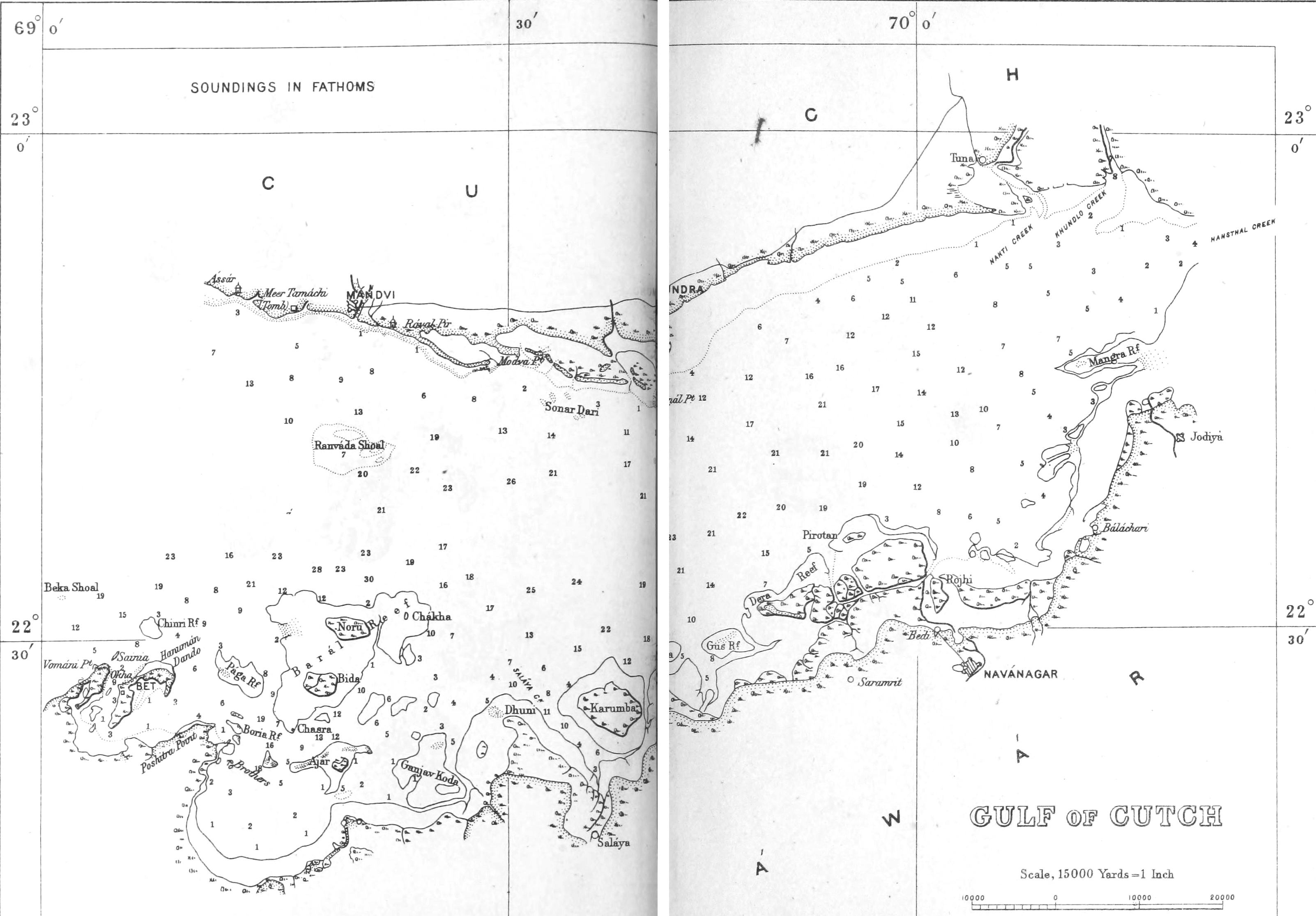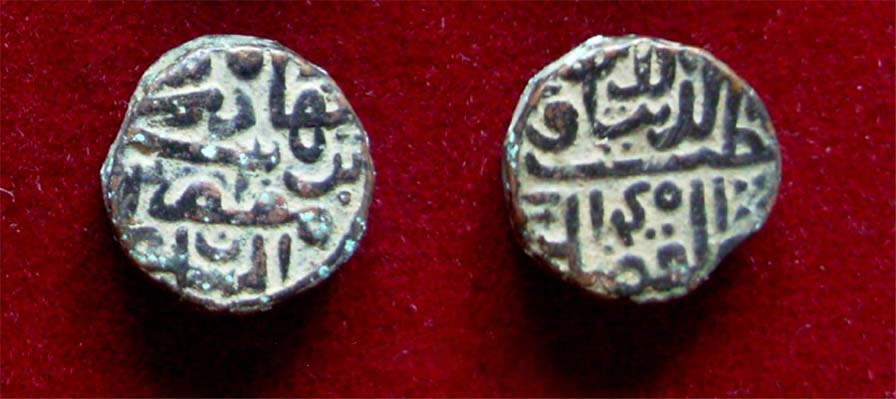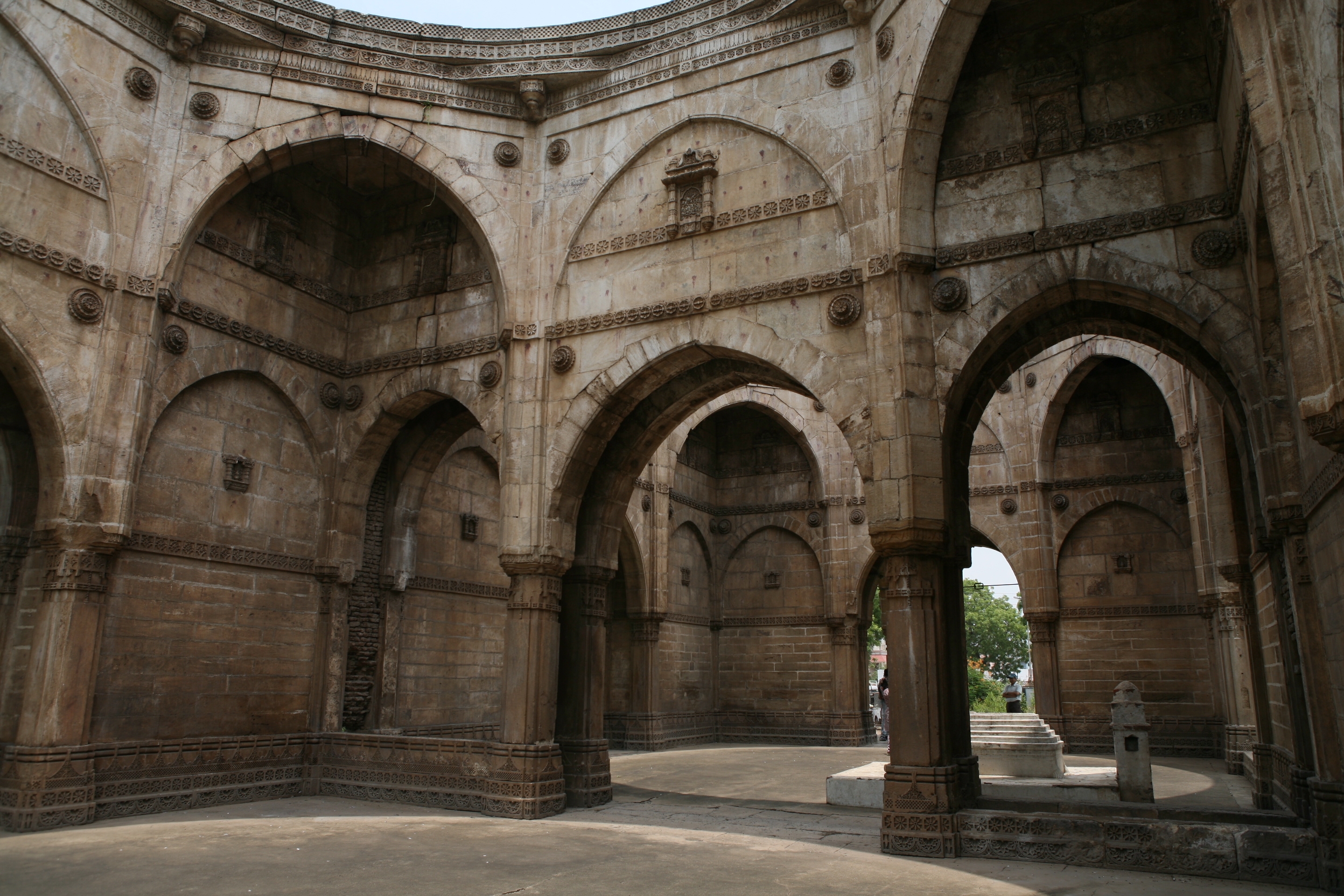|
Muzaffarids (Gujarat)
The Muzaffarid dynasty, sometimes referred as Ahmedabad dynasty, were Sultans of Gujarat in western India from 1391 to 1583. The founder of the dynasty was Zafar Khan (later Muzaffar Shah I) who was governor of Gujarat under the Delhi Sultanate. Zafar Khan's father Sadharan, has been variously described as a Tank Rajput or a Khatri convert from Hinduism to Islam from southern Punjab. He adopted the name Wajih-ul-Mulk. Originally from southern Punjab, his Hindu forebearers claimed descend from Rāmachandra, who the Hindus worshipped as God. Such genealogies were fabricated to glorify royalty and were generally not accepted. When the Sultanate was weakened by the sacking of Delhi by Timur in 1398, and Zafar Khan took the opportunity to establish himself as sultan of an independent Gujarat. His son, Ahmed Shah I established the capital at Ahmedabad. The dynasty ruled for almost 200 years, until the conquest of Gujarat by the Mughal Empire in 1572. The sultanate reached its peak of ... [...More Info...] [...Related Items...] OR: [Wikipedia] [Google] [Baidu] |
Sultanate Of Gujarat
The Gujarat Sultanate (or the Sultanate of Guzerat), was a Medieval Indian kingdom established in the early 15th century in Western India, primarily in the present-day state of Gujarat, India. The dynasty was founded by Sultan Zafar Khan Muzaffar, whose ancestors were Tāṅks from southern Punjab. He rose to the nobility after marriage of his sister with Firuz Shah Tughlaq, the Delhi Sultan, and would become the Governor (Naib) of Gujarat under the Delhi Sultanate. Zafar Khan defeated Farhat-ul-Mulk near Anhilwada Patan and made the city his capital. Following Timur's invasion of the Delhi Sultanate, the city was devastated and weakened considerably, so he declared himself independent from Delhi in 1407, and formally established the Sultanate of Guzerat. The next sultan, his grandson Ahmad Shah I moved the capital to Ahmedabad in 1411. His successor Muhammad Shah II subdued most Rajput chieftains. The prosperity of the sultanate reached its zenith during the rule of Mahmud B ... [...More Info...] [...Related Items...] OR: [Wikipedia] [Google] [Baidu] |
Gulf Of Kutch
The Gulf of Kutch is located between the peninsula regions of Kutch and Saurashtra, bounded in the state of Gujarat that borders Pakistan. It opens towards the Arabian Sea facing the Osman Gulf. It is about 50 km wide at the entrance before narrowing into marshland, creeks and inlets. The south coast is bordered by islands, mud flats and coral reefs, due to the large amount of marine life found in this region it has large sections of it have become protected as parks and sanctuaries. The northern side is lined with extensive mud flats, the largest of which lie between Mundra and Kuvay. Also, a large portion of the shipping harbours in the region are located on the northern side including Māndvi, Bedi, and Kandla. Maximum depth of the Gulf of Kutch is around 123m (403 ft). Additionally, there are numerous shoals at the mouth of the gulf namely Lushington, Ranwara, Bobby and Gurur. The gulf expands deep into Gujarat with a length of approximately 150 km before becoming ... [...More Info...] [...Related Items...] OR: [Wikipedia] [Google] [Baidu] |
Mahmud Shah III Of Gujarat
Nasir-ud-Din Mahmud Shah III, born Mahmud Khan was a sultan of the Muzaffarid dynasty who reigned over the Gujarat Sultanate, a late medieval kingdom in India from 1537 to 1554. He had to battle frequently with his nobles who were interested in independence, especially Darya Khán and Imád-ul-Mulk. He was killed by one of his servants. Background Bahadur Shah had no son, hence there was some uncertainty regarding succession after his death. Muhammad Zaman Mirza, the fugitive Timurid prince made his claim on the ground that Bahadur's mother adopted him as her son. The nobles selected Bahadur's nephew Miran Muhammad Shah I of Khandesh as his successor, but he died on his way to Gujarat. Finally, the nobles selected Mahmud Khan, the son of Bahadur's brother Latif Khan as his successor and he ascended to the throne as Mahmud Shah III on 10 May 1538, when only eleven years of age.Majumdar, R.C. (ed.) (2007). ''The Mughul Empire'', Mumbai: Bharatiya Vidya Bhavan, , pp.391-8 Reig ... [...More Info...] [...Related Items...] OR: [Wikipedia] [Google] [Baidu] |
Farooqi Dynasty
Farooqui ( ar, الفاروقي); also transliterated as Farooqi, Faruki or Al Farooqui), is a distinct name or surname or last name of Arabic origin. Notable Farooquis * Umar, second Caliph of Islam associate of Muhammad * Hafsa bint Umar, wife of Muhammad * Abdullah ibn Umar brother-in-law of Muhammad * Farooque (1948), Bangladeshi actor * Farouk Ruzimatov, Russian ballet dancer * Farouk Shami, Palestinian-American businessman * Farouk al-Sharaa, Syrian politician * Farooq, professional wrestler (ring name) * Khwaja Ghulam Farid, Sufi Poet * Mian Mir ( Sufi saint) * Baba Fariduddin Ganjshakar (Sufi venerated by Muslims, Hindus and Sikhs) * Shaikh Ahmad Sirhindi scholar * Muhibullah Allahabadi, Sufi Scholar * Ibrahim ibn Adham , Sufi saint * Ismail al-Faruqi, Palestinian-American philosopher * Sachal Sarmast, Sufi Saint * Shaikh Salim Chisti, Sufi Saint * Naseer Ahmad Faruqui, Islamic scholar * Nisar Ahmed Faruqi, Islamic scholar * Musharraf Ali Farooqui, Canadian ... [...More Info...] [...Related Items...] OR: [Wikipedia] [Google] [Baidu] |
Humayun
Nasir-ud-Din Muhammad ( fa, ) (; 6 March 1508 – 27 January 1556), better known by his regnal name, Humāyūn; (), was the second emperor of the Mughal Empire, who ruled over territory in what is now Eastern Afghanistan, Pakistan, Northern India, and Bangladesh from 1530 to 1540 and again from 1555 to 1556. Like his father, Babur, he lost his empire early but regained it with the aid of the Safavid dynasty of Persia, with additional territory. At the time of his death in 1556, the Mughal Empire spanned almost one million square kilometres. In December 1530, Humayun succeeded his father to the throne of Delhi as ruler of the Mughal territories in the Indian subcontinent. Humayun was an inexperienced ruler when he came to power, at the age of 22. His half-brother Kamran Mirza inherited Kabul and Kandahar, the northernmost parts of their father's empire. The two half-brothers would become bitter rivals. Humayun lost Mughal territories to Sher Shah Suri, but regained the ... [...More Info...] [...Related Items...] OR: [Wikipedia] [Google] [Baidu] |
Interregnum
An interregnum (plural interregna or interregnums) is a period of discontinuity or "gap" in a government, organization, or social order. Archetypally, it was the period of time between the reign of one monarch and the next (coming from Latin ''inter-'', "between" and ''rēgnum'', "reign" rom ''rex, rēgis'', "king", and the concepts of interregnum and regency therefore overlap. Historically, longer and heavier interregna have been typically accompanied by widespread unrest, civil and succession wars between warlords, and power vacuums filled by foreign invasions or the emergence of a new power. A failed state is usually in interregnum. The term also refers to the periods between the election of a new parliament and the establishment of a new government from that parliament in parliamentary democracies, usually ones that employ some form of proportional representation that allows small parties to elect significant numbers, requiring time for negotiations to form a governmen ... [...More Info...] [...Related Items...] OR: [Wikipedia] [Google] [Baidu] |
Bahadur Shah Of Gujarat
Qutb-ud-Din Bahadur Shah, born Bahadur Khan was a sultan of the Muzaffarid dynasty who reigned over the Gujarat Sultanate, a late medieval kingdom in India from 1526 to 1535 and again from 1536 to 1537. He ascended to throne after competing with his brothers. He expanded his kingdom and made expeditions to help neighbouring kingdoms. In 1532, Gujarat came under attack of the Mughal Emperor Humayun and fell. Bahadur Shah regained the kingdom in 1536 but he was killed by the Portuguese on board a ship when making a deal with them. The army of Bahadur Shah included the Koli tribe and Abyssinians. The Kolis of Gujarat attacked the Humayun in the help of Bahadur Shah at the Gulf of Khambhat. Early years Bahadur Shah's father was Shams-ud-Din Muzaffar Shah II, who had ascended to the throne of the Gujarat Sultanate in 1511. Muzaffar Shah II nominated Sikandar Shah (Bahadur Shah's elder brother) as the heir apparent to the throne. Bahadur Khan's relationship with his brother and father ... [...More Info...] [...Related Items...] OR: [Wikipedia] [Google] [Baidu] |
Mahmud Shah II Of Gujarat
Mahmud is a transliteration of the male Arabic given name (), common in most parts of the Islamic world. It comes from the Arabic triconsonantal root Ḥ-M-D, meaning ''praise'', along with ''Muhammad''. Siam Mahmud *Mahmood (singer) (born 1992), full name Alessandro Mahmoud, Italian singer of Italian and Egyptian origin *Mahmoud (horse) (foaled 1933), French-bred, British-trained Thoroughbred racehorse and sire *Mehmood (actor), Indian actor, singer, director and producer Given name Mahmood *Mahmood Ali (1928–2008), Pakistani radio, television and stage artist * Mahmood Hussain (cricketer) (1932–1991), Pakistani Test cricketer * Mahmood Hussain (councillor), former Lord Mayor of Birmingham, England *Mahmood Mamdani (born 1946), Ugandan academic, author and political commentator * Mahmood Monshipouri (born 1952), Iranian-born American scholar, educator, and author *Mahmood Shaam (born 1940), Pakistani Urdu language journalist, poet writer and analyst *Mahmood (singer) (born ... [...More Info...] [...Related Items...] OR: [Wikipedia] [Google] [Baidu] |
Sikandar Shah Of Gujarat
Sikandar Shah, born Sikandar Khan, was a ruler of the Muzaffarid dynasty, who reigned over the Gujarat Sultanate for few weeks before his murder in 1526. Reign Gujarat Sultan Muzaffar Shah II died at Ahmedabad on 5 April 1526 after formally appointing his son Sikandar Khán his heir, who soon assumed the reign with title of Sikandar Shah. Bibi Rani was his mother. Three days later, he left for Muhammadabad-Champaner. When Bibi Rani died, she had requested Imád-ul-Mulk Khush Kadam, a slave, to befriend Sikandar. He therefore resented the continuation of Khudawand as the Chief Minister (''Vazir'') in of appointing him. Some people had told him that the Sultan would get him killed.Majumdar, R.C. (2006). ''The Delhi Sultanate'', Mumbai: Bharatiya Vidya Bhavan, pp. 167-169 The Bukhari Sayyid of Vatva, the descendants of the Saint Burhanuddin Qutb-i-Alam, were influential in the Sultanate. Sayyid Shah Sheikhji who was then the head of the family. He had predicted that Bahadur Khan, ... [...More Info...] [...Related Items...] OR: [Wikipedia] [Google] [Baidu] |
Muzaffar Shah II
Shams-ud-Din Muzaffar Shah II or Muzafar II, born Khalil Khan, was a Sultan of the Muzaffarid dynasty, who reigned over the Gujarat Sultanate from 1511 to 1526. He was the eldest son of Sultan Mahmud Begada and his Rajput wife, Rani Hírabai. He subdued the princely state of Idar but came in conflict with Rana Sanga of Mewar when he captured Malwa. Reign Mahmud Begada was a prominent ruler of the Muzaffarid dynasty. He had four sons: Khalíl Khan, Muhammad Kala, Apa Khan, and Ahmed Khan. On ascending the throne at the age of twenty-seven, Khalíl adopted the title of Muzaffar Shah. For some time before his father’s death, Prince Khalíl Khan had been living at Baroda (now Vadodara), and shortly after his accession, he visited that neighborhood and founded a town named Daulatabad. In 1514, Rao Bhím, the son of Rao Bhan of Idar State, defeated Ain-ul-Mulk, governor of Patan, who was coming to Ahmedabad to pay his respects to the king. The officer had turned aside to punish ... [...More Info...] [...Related Items...] OR: [Wikipedia] [Google] [Baidu] |
Daud Shah Of Gujarat
Daud Shah, born Daud Khan, was a ruler of the Muzaffarid dynasty, who reigned over the Gujarat Sultanate from few days in 1458. On the death of Gujarat Sultan Qutb-ud-dín Ahmad Shah II, the nobles raised to the throne his uncle Daud, son of Ahmad Shah I. But as Daud appointed a carpet-spreader to high offices and committed improper acts, he was deposed after reign of seven or, according to some source twenty seven days. In 1459 his half-brother Fateh Khán, the son of Muhammad Shah II by Bibi Mughli, a daughter of Jám Júna of Samma dynasty ruling from Thatta in Sindh; was seated on the throne at the age of little more than thirteen with the title of Mahmúd Sháh I, later popularly named Mahmud Begada Sultan Mahmud Begada or Mahmud Shah I (), was the most prominent Sultan of the Gujarat Sultanate. Raised to the throne at young age, he successfully captured Pavagadh and Junagadh forts in battles which gave him his name ''Begada''. He establi .... References Gujar ... [...More Info...] [...Related Items...] OR: [Wikipedia] [Google] [Baidu] |
Ahmad Shah II
Qutb-ud-Din Ahmad Shah II, born Jalal Khan, was a ruler of the Muzaffarid dynasty, who reigned over the Gujarat Sultanate from 1451 to 1458. He defeated invading Malwa forces at the battle of Kapadvanj. He tried to capture Nagor and came in conflict with Rana Kumbha of Chittor. Reign In 1451, after death of Muhammad Shah II, the nobles placed his son Jalál Khán on the throne with the title of Kutb-ud-dín or Qutb-ud-dín Ahmad Shah II. Sultán Mahmud Khilji of Malwa Sultanate had invaded Gujarat and had laid siege to Sultánpur. Malik Alá-ud-dín bin Sohráb Kutb-ud-dín's commander surrendered the fort, and was sent with honour to Málwa and appointed governor of Mandu. Sultán Mahmúd, marching to Sársa-Páldi, summoned Bharuch, then commanded by Sídi Marján on behalf of Gujarát Sultanate. The Sídi refused, and fearing delay, the Málwa Sultán after plundering Baroda (now Vadodara) proceeded to Nadiad, whose Bráhmans astonished him by their bravery in killing ... [...More Info...] [...Related Items...] OR: [Wikipedia] [Google] [Baidu] |






